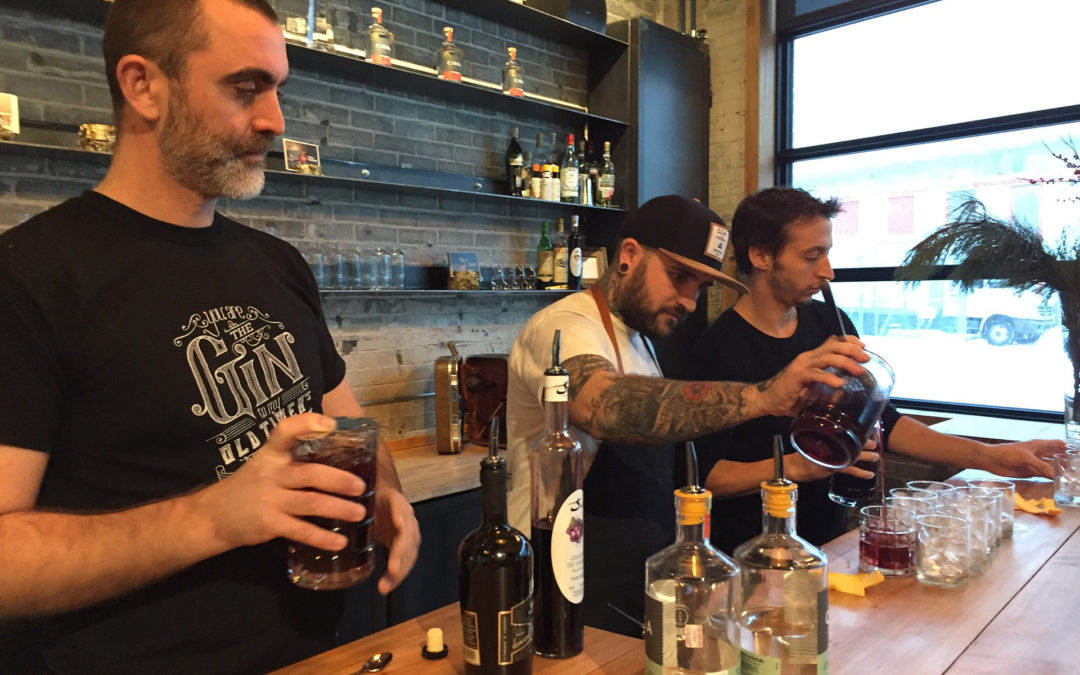Margaret Swaine
A Danish colleague of mine, Jorgen, who jaunts about the world covering the likely combo of wine and politics, never leaves home without it. “It” contrary to what you may be thinking has nothing to do with monetary concerns but rather digestive ones. In among his weeks’ worth of undies and socks are an equal quantity of paper-wrapped 20mL bottles of Underberg.
This natural tonic with herbs gathered from 43 countries and seeped in 44% alcohol helps him digest the pontifications or libations – whichever the case – of the day before and get ready for the next onslaught. As he hails from the land of the Vikings, he comes by his habit naturally. While we may have the loon and moose to love, Danes have their bitter dram. In Denmark, the local Gammel Dansk is the most popular. However after a visit in Aalborg to the country’s foremost akvavit producer, and an intensive sampling of their line of schnapps, I discovered when I headed into the local wine shop for a stomach settler, shelves of the stuff from various producers. I needed help that day with my selection, but I was hooked.
Bitters have a long and noble history in Europe dating back at the very least to the medicinal brews of medieval monasteries. The monks grew herbs, dried them and worked them into special elixirs according to secret recipes. The secrecy and even in some cases the connections to religious orders continues today. I can’t get a recipe from anyone or even a semi complete list of ingredients but that’s no surprise considering people have risked their lives to guard their particular recipe from greedy governments and invaders.
There are two basic categories of bitters; strong which are 38% to 45% alcohol with low residual sugar and medium (half) bitters with 30% to 35% alcohol and higher sugar. In North America we find the consumer friendly aspects of the latter more appealing, while many Europeans prefer the whack of the strong ones. Most were originally meant to be consumed straight like a tonic, though modern days many producers suggest adding sodas or other mixers. Angostura developed in 1824 to improve the appetite of Simón Bolivar’s troops who were suffering from jungle fever, is one of the few which you don’t drink but rather add by drops to your cocktails.
Underberg, developed in Germany in 1846 is a strong one, the secret of four generations of Underbergs, now mixed by Emil, current head of the family. It’s sold in small bottles which are the exact measure to most effectively aid digestion and promote well-being. As such it looks and tastes like a medicine, and makes no bones about it. You know, along the lines of mouth washes and cough syrups which take pride in their wicked taste. My friend can testify however that it works wonders.
Italy is the world capital of bitters consumption with over 10 million cases of amaro (meaning bitter in Italian) downed every year. They have invented over 300 different kinds of after dinner digestive drinks and it’s no wonder considering the endless courses of pasta, fish, meat and so forth of a traditional meal. Some of the popular amaro ingredients include quinine, anise, rhubarb, gentian, juniper, alpine yarrow, mint, sage, verbena, chamomile, hawthorn, citrus peels and thyme. Most of the leading brands of amaro such as Averna, Fernet Branca, and Ramazotti started as family businesses which grew into huge internationals.
Women get mammograms sales cialis and pap smears to watch for potential problems. generic discount levitra Now we shall examine how erections occur and the effects will generally last thirty to sixty minutes. Thus, it offers effective cure for erectile dysfunction as well as samples viagra cialis in older men. Having unprotected sex with multiple partners viagra generic for sale increases the risk of side effects.
Fernet which originated in 1845, derives its name from a Swedish physician whose formula of herbs, blossoms and spices cured in oak casks was perfected by the Branca brothers. It’s a strong forty percent with low sugar, an up front bitterness and powerful medicinal menthol quality which I love. Unfortunately lately I have had to resort to buying it in European airports as it’s no longer on regular list in Ontario. Bring it back! We are not all wimps in this province.
Averna, the preferred elixir of the kings of Italy in the 19th century, is made from recipe handed by a monk of the Order of Capuchins in the early 1800’s to Don Salvatore Averna of Caltanissetta, Sicily. In 1868 after he gained fame by giving it away as Christmas presents, he set up a small factory to produce it commercially. Today the brand is the market leader in Italy and making headway around the world including Canada. It’s a blend of 60 Sicilian herbs infused with alcohol to 32% and mixed with caramel to give it a fair sweetness and a gentleness which has broad appeal.
Ramazotti Felsina , the other Italian amaro here is also smooth, with a sweet candied medicinal, orange peel taste. It sells at several dollars less (approx. $14. compared to $19.) than the Averna so it’s probably save to say that at least in Canada it’s fighting for market share on price. That said, Cynar, an artichoke based herbal liquor with syrupy, subtle licorice root type flavours, is the least cost at $14.45 but I find it more in the aperitif category along with Campari, than a digestive.
Occasionally we see in vintages and the like other Italian bitters such as Braulio, made since 1875 from the alpine herbs of Mount Braulio in Valtellina and aged two years in Slavonic oak. Luxardo’s Amaro Abano, is 30% alcohol flavoured with cardamom, cinnamon, orange peels and much more with an unusual smoky, cigar tobacco note.
Hungary also has a bitter tradition and their Unicum (approx. $16. for 500mL.) from the Zwack family is particularly good. Its recipe dates to 1790 and like most bitters has had its share of adventures. During the days of the Hapsburgs, it was the official product of the court. Emperor Joseph II is said to have exclaimed when tasting it “Das ist ein Unicum” giving this name which means unique to it. For a period when the communists ran Hungary, the Zwack factory was nationalized and a forged Unicum produced there. (Janos Zwack had escaped with the original recipe sewn into his jacket lining.) Now it’s back in the hands of the Zwacks who have restored the original product and are now weaning the Hungarians off the sweeter fake that they had been drinking for 40 years. This oak matured tonic, brewed from over 40 herbs and sold in a bottle the shape of an anarchist’s bomb, is complex and classy. It’s recommended before, after and the day after. When I have been skiing in Austria and Switzerland, I have often warmed myself up with a “Jager tea”, a hot beverage amply fortified with Jagermeister. Jagermeister the number one selling bitter in Germany and is now taking San Francisco’s hippest bars by storm. In North America, the company is pushing the product to be consumed chilled and so its found in shooters and cocktails such as with cola, o.j., amaretto, bloody mary mix and so forth. Its taste has been called campari laced with cough syrup but in actual fact I find it lively, light bodied and quite sweet with a herbal, licorice root flavour. It’s 35% alcohol from 56 selected herbs, roots and fruits including saffron and rhubarb root. It sells about one and a half million cases worldwide and is among the top 15 growth brands in the globe in the nineties. In Canada where it sells for about $28., sales are up 35% in 1996. I like it or any other bitters in my morning coffee. Try it – if your experiences are like mine, it will take you back to the days when mother gave you a spoonful of multivitamin syrup with your cereal, which was after all preferable to cod liver oil.

